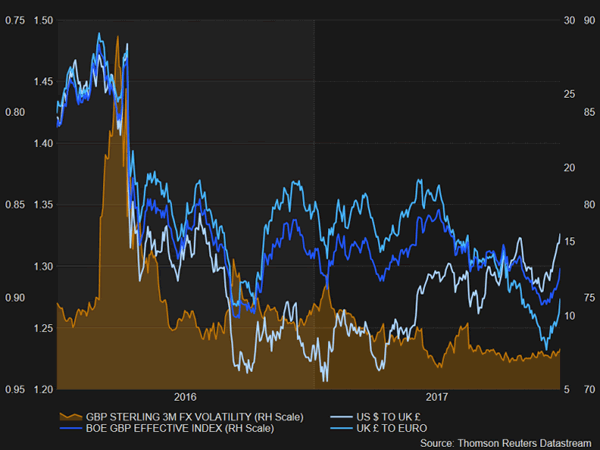Expectations that the Bank of England will take a more hawkish stance at its policy meeting this week have lifted sterling from two-month lows ploughed at the end of August, offsetting concerns about a slowing economy and a lack of progress in the Brexit negotiations.
Stronger-than-expected inflation data on Tuesday fuelled those expectations as UK consumer prices rose by an annual rate of 2.9% in August, just shy of the BoE’s upper limit of 3%, at which point the Governor Mark Carney would be required to write a letter to the UK finance minister explaining the overshoot. The pound hit a one-year high of $1.3328 earlier today but those gains were tempered after the latest UK employment data showed average weekly earnings missed expectations. UK wages rose by just 2.1% in the three months to July, underlining the predicament for the Bank of England where an unemployment rate at a 42-year low of 4.3% is not spurring higher pay growth, and in turn, causing a squeeze on household’s disposable incomes.
Another dilemma for the Bank is a weakening economy. Slowing consumer and business spending have pushed the UK to the bottom of the G7 growth league in first half of the year. The slowdown was anticipated by the Bank of England and is the main reason why it has been reluctant to raise rates even though inflationary pressures are clearly on the up.
However, the Bank has said there are limits to its tolerance of inflation overshoot and speculation has been increasing that the tolerance level has been reached for more of the BoE’s monetary policy committee (MPC) members. In June, the Bank saw its tightest vote since 2011 when three members dissented. The figure fell to two in August following the departure of one of the hawks, Kirstin Forbes. But a growing number of market participants think the Bank’s Chief Economist, Andy Haldane, will join Ian McCafferty and Michael Saunders in voting for a 25bps rate hike on Thursday.
Economists are not convinced though that a UK rate rise is nearing and are not projecting an increase in borrowing costs before 2019. Traders see a different story however and the market-implied odds of a rate hike before the end of 2018 have been rising. This has been positive for the pound, which has been looking surprisingly bullish against the US dollar since April. The pound has also perked up against the euro recently, hitting one-month high this week.
However, analysing the pairs more closely, sterling’s gains look overstated. The pound’s 7.5% gain versus the dollar this year is more to do with the greenback’s weakness than improved fundamentals for the UK economy. Against the euro, sterling has in fact been on a downtrend since May and this month’s rebound is more likely to be a technical correction than a trend reversal.
The Bank of England pays more attention to the sterling Effective Exchange Rate Index, which fell to a 10-month low when the euro peaked at an 8-year high of 0.9306 on August 29 (when excluding last October’s flash crash). The index has recovered somewhat since then but is still slightly down on the year (in contrast to the pound/dollar pair). This would worry BoE policymakers as fresh falls in sterling’s broader value could drive inflation even further above the Bank’s 2% target.

But despite the Bank’s task of justifying low interest rates becoming increasingly difficult, most analysts don’t foresee a majority of MPC members voting for a hike in the coming months, especially as, now that the committee is back to its full nine members, the dovish Governor would have the deciding vote in the event of a 50-50 split.
This explains why many investors remain bearish on the pound, particularly against the euro, which itself is benefiting from the prospect of tighter policy by the European Central Bank. Morgan Stanley predicted last month that the pound will hit parity with the euro in 2018. This view isn’t shared by most other investment banks, though many have lowered their forecasts for pound/euro, while raised them slightly for pound/dollar. The most recent Reuters poll conducted in the first week of September points to a similar picture. Median forecasts for pound/dollar in a year’s time was unchanged at $1.30, but a majority of economists raised their forecasts for euro/pound to 0.92 pounds.
The MPC vote composition at tomorrow’s meeting will be crucial in setting the trend for the pound as a 6-3 vote would fuel rate rise expectations whereas a 7-2 vote could kill the current mini rally. Judging by Carney’s previous comments, concerns about waning consumer confidence and the negative impact on businesses from the continued Brexit uncertainty will likely outweigh the unease about the upswing in inflation. The MPC will probably want to wait and see whether inflation will drop back once the initial increases from the pound’s post-Brexit depreciation start to drop out of the calculation. In the absence of a pick-up in wage growth, there is little to suggest that the current spike in inflation is not temporary.












